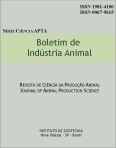Macronutrients leaf contents of corn in consortium with forage of the genus Panicum and Urochloa
Keywords:
integrated crop-livestock, nutritional status, Zea maysAbstract
In recent years, the corn crop in Brazil has undergone major technological changes, aiming at a sustainable production. This improvement may be related to appropriate management, which includes, among other practices, crop rotation and tillage; that one can get through crop-livestock integration (CLI). The CLI can be done by the consortium sequence or crop rotation with annual forages in order to recover degraded pastures. This work aimed to evaluate the macronutrient leaf content of corn intercropped with forages of the genus Panicum and Urochloa. The experiment was conducted at the Farm for Teaching, Research and Extension, Faculty of Engineering - UNESP, Ilha Solteira in an Oxisol in Savannah conditions, being in no-tillage for 8 years (previous corn crop). In nitrogen fertilization was applying 100 kg ha-1 of N as urea. The experimental design was a randomized block with four replications and five treatments: Panicum maximum cv. Tanzania sown during the nitrogen fertilization (CTD) of the corn; Panicum maximum cv. Mombaça sown during the nitrogen fertilization (CMD) of the corn; Urochloa brizantha Xaraes sown during the occasion of nitrogen fertilization (CBD) of the corn; Urochloa ruziziensis sown during the nitrogen fertilization (CRD) of the corn, and corn without intercropping (CWI). The grasses seeds were mixed with fertilizer minutes before sowing and placed in fertilizer seeder compartment and the fertilizer were deposited in the soil at a depth of 0.03 m in the amount of 5 kg ha-1. It was observed that there was no significant difference between the single corn tillage and the corn in intercropping with different modalities of forages of genus Panicum and Urochloa to foliar contents of N, P, K, Ca and Mg, demonstrating that the consortium did not influence the absorption of nutrients by corn. In respect to S, the consortium CTD, was higher only when compared at CWI, however, did not differ significantly from the others (Table 1). The absorption of nutrients by corn, are not affected when intercropped with forage Urochloa and Panicum genus, sown at the time of nitrogen fertilization of corn.
Downloads
Downloads
Published
Issue
Section
License
Os autores não serão remunerados pela publicação de trabalhos, pois devem abrir mão de seus direitos autorais em favor deste periódico. Por outro lado, os autores ficam autorizados a publicar seus artigos, simultaneamente, em repositórios da instituição de sua origem, desde que citada a fonte da publicação original seja Boletim de Indústria Animal. A revista se reserva o direito de efetuar, nos originais, alterações de ordem normativa, ortográfica e gramatical, com vistas a manter o padrão culto da língua e a credibilidade do veículo. Respeitará, no entanto, o estilo de escrever dos autores. Alterações, correções ou sugestões de ordem conceitual serão encaminhadas aos autores, quando necessário. Nesses casos, os artigos, depois de adequados, deverão ser submetidos a nova apreciação. As opiniões emitidas pelos autores dos artigos são de sua exclusiva responsabilidade. Todo o conteúdo deste periódico, exceto onde está identificado, está licenciado sob a Licença Creative Commons Attribution (CC-BY-NC). A condição BY implica que os licenciados podem copiar, distribuir, exibir e executar a obra e fazer trabalhos derivados com base em que só se dão o autor ou licenciante os créditos na forma especificada por estes. A cláusula NC significa que os licenciados podem copiar, distribuir, exibir e executar a obra e fazer trabalhos derivados com base apenas para fins não comerciais.













